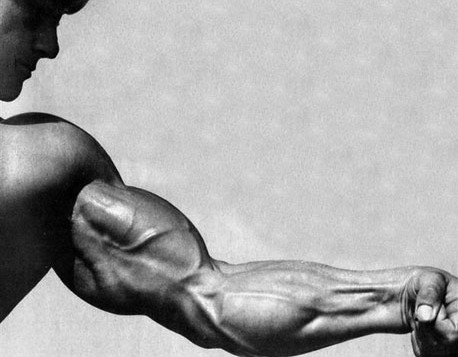While listening to some Androcell, I thought to myself, “why don’t I write a quick article about “the pump?”
The muscle pump is the phenomenon that occurs immediately following a weight training exercise, when the muscle may seem full and tight for 15 to 30 minutes. It seems to be a good indicator of one’s health and nutrition, plus it enhances muscular growth.

When “the pump” doesn’t occur after a workout, it could be a sign of a “bad” workout, an inadequate diet, or even of overtraining.
The muscle ‘pump’ is caused by plasma that is trapped within the muscle: during muscular contractions, the contractile elements (myocytes) create tension within the muscle; while the muscle shrinks due to this contraction, its diameter increases. During this event, the pressure inside of the muscle blocks the circulation of blood, increasing the pressure inside of the capillaries and forcing some of the plasma to leave the blood vessels. It is thus this plasma that gets stored in the muscle.
Muscles remain pumped so long as blood “over-pressure” persists- that is, until the plasma is evacuated.
Now, lets see why “the pump” can be of interest.
Muscle pump and muscle growth
It seems that the pump is as useful as the burn caused by lactic acid (I will write about this later) for muscle growth. What makes things interesting is that the pressure within the muscle is caused, as we saw, by an increased influx of blood within this muscle, which signifies that more nutriments are being brought to the muscle. Not only is growth thus optimized, but the muscle also recovers more quickly!
Contrarily, if your workouts do not provoke a pump the muscles may not increase in size, but you will progress anyways 🙂

Congestion, soreness, and recovery
Another benefit of a muscle pump is its ability to enhance recovery between two workout sessions. A training using light weights, but with long sets, mainly based on acquiring the pump will
– Bring oxygen and nutrients to muscles and articular bones
– Enhance the evacuation of anabolic wastes (article to come)
– Enhance the blood circulation
…which will lead to a quicker recovery. This will help you reduce your level of soreness.
Congestion, health and nutrition
The muscle pump can also be a good indicator of how well your body is performing- and it’s capacity to respond to effort and recover. Although not systematic, you can deduce the following things if a pump does not occur:
- Overtraining
- Lack of nutriments (mainly glucose)
- “Bad” workout (Time to take a rest 😀 )
Over-training
I have decided to include this small a parte, since this point is often forgotten 🙂
Over-training sucks- it means that you have overly worked your body, impacting it’s ability to recover. The body is “tired” and is unable to recover between training sessions. Progress will be non-existent, injuries likely to occur AND the hormonal system will go crazy- especially impacting one’s libido
Muscle pump and training sessions
You are now able to define your goals: gaining volume or becoming stronger. I am not saying you can’t have both, but each person as his/her own pace, and usually sticks to it. “Slower” individuals will increase their strength through the months, and “speedy” individuals will rather gain volume. For the same period of time, the former will be able to push heavier.


